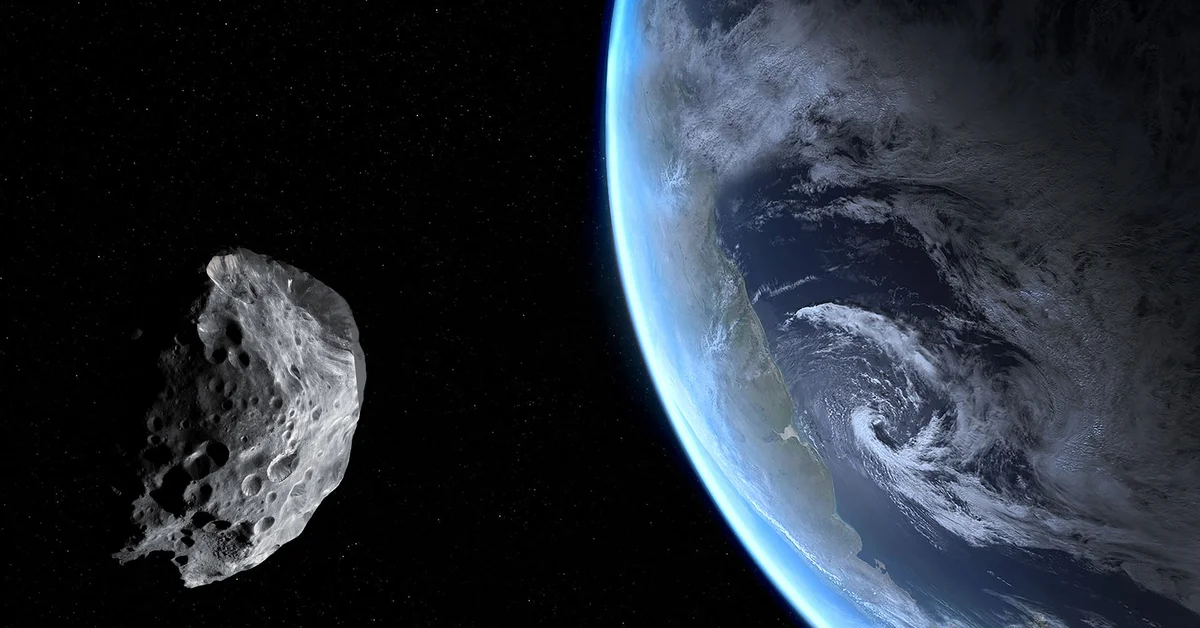On January 8, 2014, a small rock erupted in the skies over the islands of Papua New Guinea in the Pacific Ocean. After entering the Earth’s atmosphere at full speed, this phenomenon did not attract the attention of astronomers.
But over time, Amir Siraj Y Avi Lope, Astronomers at Harvard University, Recovered records of Verifies the impact of the atmosphere and the fact that this meteorite reached Earth at an extraordinary speed: 210,000 km / h, faster than the normal speed of rocks belonging to our solar system. In addition, the path of its orbit made it clear that the rock ‘did not come from here’, but formed very distant in some distant planetary system of distant stars.
That space rock was actually the first known object from another star system. Confirmed today by United States Space Command (USSC) In the newly published note, And previously classified. Confirmation supports innovation The first galaxy meteorite This was initially mentioned by Harvard theoretical astronomer Amir Siraj and his mentor Avi Lope. Study posted on preprint server arXiv In 2019.
:quality(85)/cloudfront-us-east-1.images.arcpublishing.com/infobae/NNWY2H2DJJDXDEGG2H6HBWMPOU.jpg 420w,https://www.infobae.com/new-resizer/25A7IchDXoOhvbd64kTyOK92zpk=/768x432/filters:format(webp):quality(85)/cloudfront-us-east-1.images.arcpublishing.com/infobae/NNWY2H2DJJDXDEGG2H6HBWMPOU.jpg 768w,https://www.infobae.com/new-resizer/2V17neMEL4hSf32pNGWbre-POy0=/992x558/filters:format(webp):quality(85)/cloudfront-us-east-1.images.arcpublishing.com/infobae/NNWY2H2DJJDXDEGG2H6HBWMPOU.jpg 992w,https://www.infobae.com/new-resizer/cshuxCHQN5MV8eDWPT3s95sGFDw=/1200x675/filters:format(webp):quality(85)/cloudfront-us-east-1.images.arcpublishing.com/infobae/NNWY2H2DJJDXDEGG2H6HBWMPOU.jpg 1200w,https://www.infobae.com/new-resizer/5NgOZAvoPqNnV4HTZ-sR8sxxtzY=/1440x810/filters:format(webp):quality(85)/cloudfront-us-east-1.images.arcpublishing.com/infobae/NNWY2H2DJJDXDEGG2H6HBWMPOU.jpg 1440w)
In the 2019 study, The researchers argued that the meteorite’s velocity – just 0.45 meters in diameter and traveling at 210,000 km / h in space – was 99% certain that the object appeared farther away than its orbit. Beyond our solar system, Perhaps “from the deep interior of a planetary system or a star in the Milky Way’s dense disk,” the authors wrote. Although they were convinced, the pair of scientists faced serious difficulties in reviewing their research colleagues due to the bureaucracy surrounding the object of study.
The team’s work has not yet been published in the journal Science. He backtracked on some of the data needed to verify his calculations, which were considered to be classified by the US government.
:quality(85)/cloudfront-us-east-1.images.arcpublishing.com/infobae/5EM4JNKDOVHIBFQCZDGHVOPVPA.JPG 420w,https://www.infobae.com/new-resizer/aULW8jsuZ8kSCejNU-m7ZFIsWNk=/768x768/filters:format(webp):quality(85)/cloudfront-us-east-1.images.arcpublishing.com/infobae/5EM4JNKDOVHIBFQCZDGHVOPVPA.JPG 768w,https://www.infobae.com/new-resizer/Gz2YFYiXdSXzJuN4hcdu7f-WET0=/992x992/filters:format(webp):quality(85)/cloudfront-us-east-1.images.arcpublishing.com/infobae/5EM4JNKDOVHIBFQCZDGHVOPVPA.JPG 992w,https://www.infobae.com/new-resizer/Km9yHV4dod5wqB-uLOOhRQtbMIc=/1200x1200/filters:format(webp):quality(85)/cloudfront-us-east-1.images.arcpublishing.com/infobae/5EM4JNKDOVHIBFQCZDGHVOPVPA.JPG 1200w,https://www.infobae.com/new-resizer/gYY28swYW3Ww2-HitJ3TJMMCrfc=/1440x1440/filters:format(webp):quality(85)/cloudfront-us-east-1.images.arcpublishing.com/infobae/5EM4JNKDOVHIBFQCZDGHVOPVPA.JPG 1440w)
USSC: “Effectively a galaxy”
In a note dated March 1 and shared on Twitter on April 6, Lt. Gen. John E. Shaw, USSC’s deputy commander, wrote that the analysis of the 2019 fireball was “accurate enough to confirm the path between the stars.”.
Now, USSC scientists have officially confirmed their findings. At the Space Foundation’s annual space symposium, John Shaw, deputy commander of the U.S. Space Command, declared that “interstellar matter is actually a galaxy.” Now in the classified note. The note further states that this confirmation makes 2014 the meteorite the first galaxy to be discovered in our solar system.
:quality(85)/cloudfront-us-east-1.images.arcpublishing.com/infobae/N6SP3LXVRRBRPJLXPDLZPMID6U.JPG 420w,https://www.infobae.com/new-resizer/gkdYCO7YOw2aIMm4_C0TDktKvOg=/768x432/filters:format(webp):quality(85)/cloudfront-us-east-1.images.arcpublishing.com/infobae/N6SP3LXVRRBRPJLXPDLZPMID6U.JPG 768w,https://www.infobae.com/new-resizer/YQ2yWeEyLtnfX59rO1WFFlA4T20=/992x558/filters:format(webp):quality(85)/cloudfront-us-east-1.images.arcpublishing.com/infobae/N6SP3LXVRRBRPJLXPDLZPMID6U.JPG 992w,https://www.infobae.com/new-resizer/inXVtxgpL8uYxhqSeIy5TrLChao=/1200x675/filters:format(webp):quality(85)/cloudfront-us-east-1.images.arcpublishing.com/infobae/N6SP3LXVRRBRPJLXPDLZPMID6U.JPG 1200w,https://www.infobae.com/new-resizer/pPU3G1iznnC31nJn6tty7D4g_zM=/1440x810/filters:format(webp):quality(85)/cloudfront-us-east-1.images.arcpublishing.com/infobae/N6SP3LXVRRBRPJLXPDLZPMID6U.JPG 1440w)
The discovery of the meteorite follows the recent discovery of two other galaxies in our solar system., Known as’Omuvamuwa – A now-popular cigar-shaped object moving much faster than it appeared in our solar system – and the comet Borisov, they are very large and have no close contact with Earth.
Too, Avi LopeAstronomer Harvard University, He went even further and began a controversial hypothesis: Oumuamua Remnants of an alien spacecraft. Since Oumuamua is now out of range of the most powerful telescopes it can no longer be seen. But as the debate over its origin intensified, one team outlined an ambitious plan to send a probe to capture the mysterious space object inevitably moving further away from Earth.
This work could begin as early as 2028 When it leaves our solar system between 2050-2054 it reaches Oumuamua according to its speed and direction of travel, once ending with the mystery of its origin.
:quality(85)/cloudfront-us-east-1.images.arcpublishing.com/infobae/TWWGXVWPQZFUVHG54CS6QFQBDY.jpg 992w)
Although no material was found in Papua New Guinea Glamor From Omuvamuwa, According to a US government report, its discovery precedes it, making it the first galaxy to be discovered in our solar system.
Look for interstellar trash
Siraj has made the request He still wants to publish the original study so that the scientific community can take the place he and his colleagues left behind. He said as the meteorite burned in the South Pacific Ocean, fragments of the material may have sunk into the water and built a nest on the coast. Although finding the galaxy debris is an almost impossible task, Siraj said he is already consulting with experts about loading a mission to recover it.
Siraj, director of interstellar object studies at Harvard’s Galileo project, said: “It excites me to think that there is an interstellar object that has reached Earth and we know where it is.”One thing I’m going to check – I’m already talking to people – is whether I can search the sea floor off the coast of Papua New Guinea. See if we can get any snippets, ”he added.
Continue reading:


:quality(85)/cloudfront-us-east-1.images.arcpublishing.com/infobae/LBIVO7473VDJVIOHOP577YLWDU.jpg)
:quality(85)/cloudfront-us-east-1.images.arcpublishing.com/infobae/OLNQLJRERZDCRBK5TW2XPCFNTU.jpg)

:quality(85)/cloudfront-us-east-1.images.arcpublishing.com/infobae/VYMZLY2LCVF7JLLP2QY5TOANM4.jpg)